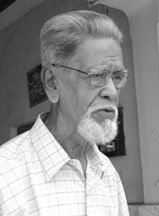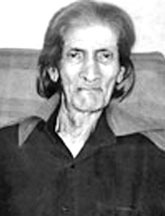Muslim musicians enriched Sinhala music
By Amal HEWAVISSENTI
The major contributions made by Muslim musicians to Sri Lankan film
music a few decades previously is ranked superbly excellent. The Muslim
musicians' active involvement brought in a multicultural perspective to
the Sinhala music arena and exploded the myths within Muslim communities
towards music. The truly positive concern of Muslim musicians to Sinhala
music directly appealed to a predominantly young, ethnically mixed
audience in Sri Lanka who were limited in their chance to be exposed to
multiple forms of music. The Islamic religious outlook has an approach
to fine arts which is often misinterpreted to be rather sceptical.
 |
|
M Ghouse |
Some view Islam's approach to arts as condemnatory. In short, they
give a Satanic quality to some forms of art specially music before the
Muslim community and therefore professional Muslim musicians are a rare
thing in Sri Lanka.
In this context, the emergence of Muslim musicians to contribute
lavishly to Sinhala film music was and is very special thing because
even the few musical masterpieces by them stand out with wider appeal
for all times.
In whatever way the international role of Muslim musicians is
admirably noted because they have gained influence over fine arts
specially music.
A few decades back, Sri Lankan Muslim musicians were widely
popularised by gramophone records and radio media. Several such
musicians are distinguishable within the boundaries of Sri Lankan cinema
music largely nourished by Indian music during '50s, '60s and '70s. They
were Mohammed Ghouse, Nohammed Salee, T. N. Latheef, Harun Lantra,
Mohideen Baig, J. M. M. Saadik, M. B. Hussain Aliyar and so forth.
Music classes
The first and most noticeable of these Muslim musicians was Mohommed
Ghouse (Ghouse Master) who brought in a larger musical legacy from India
in order to produce an upshot of Sri Lankan musicians with definite Sri
Lankan identity.
His role in Sri Lankan music dealt a humiliating rebuff to the
sceptical attitudes held by Muslim community towards music and its use.
The gramophone and radio made this trend of music enterprise move in
sharp acceleration when more musicians and singers shot to fame in
Sinhala film music. The first half of 1960s saw a major breakthrough in
reawakening of Sinhala music specially film music. It was the music
classes primarily conducted by Sangeeth Visharad S. de S.
Jayasekaraingha who was then the lecturer for music at the Government
Institution of Fine Arts. The idea of classes for Muslim students of
music was originally planned and sponsored by M. B. M. Ghouse (This is
not Mohommed Ghouse the musician) who was a lecturer for painting at
Government Institution of Fine Arts.
The class which comprised a batch of about 40 Muslim students of
music was conducted in Government College of Music for three days per
week. This really was for the first time in Sri Lanka.
Mohideen Baig, N. M. Maharoof, T. M. Tajudeen, M. M. Buhari, M.
Subair Kareem, Mohommed Salee, O. Shariff, Harun Lantra, to quote a few
who studied music under S. de S. Jayasekara. The class was held for
three years and the management took care to test the students' academic
and practical performance in music at the end of every year.
The musician with rare flair
Meanwhile, a prominent student of above said class, Mohammed Salee
emerged as a major figure in the field of Sri Lankan music and his role
professionally defined his career. In 1958 he was introduced to a cinema
orchestra as a harmonium player under the guidance of veteran musician.
R. M. Chandrasena. Prior to this, Salee (Master Salee) had sprung to be
a popular key figure playing harmonium at parties (Peduru Sajjas) at
houses of higher class families. His maiden performance in an orchestra
was in the film "Wanaliya".
As Salee was professionally involved in direction of film music, some
singers, film directors and producers highly exploited his skills to
compose low-quality melodies which fell far short of musical standards.
Those melodies were chiefly suggestive of, or rather imitative of
melodies of Hindi and Tamil songs, but this trend of imitation was an
indelible blemish on otherwise promising aspects of music as a form of
mass entertainment.
Salee's contribution
 |
|
Harun Lantra |
Yet these 'borrowed' melodies won him a rapturous applause from Sri
Lankans at that time. Musicians like Salee could not employ most of his
own creative music to glamorise the films for which he directed music.
This happened because he had to give in to the 'authority of preference'
to Hindi and Tamil music by most film directors and producers who were
solely bent on popularizing their cinematic works.
His maiden music direction for the film "Mangalika" in 1963 struck
the keynote of his musical supremacy which absolutely brought him a
chance to work in partnership with good musicians and vocalists of the
time.
Mohammed Salee directed music for about 18 films and while he was
involved in music direction in some of them, he managed to get the
combined support of veteran musicians and vocalists like Sarath
Dasanayake, Premasiri Khemadasa, Shelton Premarathne, Mohideen Baig and
Alfred Corea.
It appears fair to say that Mohommed Salee contributed several
immortal tuneful melodies to the treasury of Sinhala music and they
still remain with unabated fascinations for the Sri Lankan audience.
Among his own creations are the popular hits "Muladi Benda
Aadarayaka", Ran eta pota ridi hawadi" (Sung by H. R. Jothipala).
"Sandun gasaka ethi saman lathawaka", "Ruwan Medura", "Oba tharamata maa
nelawu", "Esa rendunu rendunu thenwala" (vocalized by Milton Perera),
"Oruwaka Paawena", Paaya a sanda", "Etha epita dura aakase" (vocalised
by Milton Mallawarachchi) etc.
Passion to imitate Nayyar
Nothing more inspired and influenced Salee's musical lifestyle than
the impressive image of O. P. Nayyar of India. It is popularly known
that Salee openly imitated Nayyar and so successful was he in his
imitation that he came to be lovably labelled as Sri Lankan Nayyar.
His undisguised admiration for Nayyar's music and style was so
fervent that he even went to great expenses to go to India and meet
Indian maestros. It is said that once he managed to discuss music with
Indian Maestros such as Naushad, Madan Mohan and Shankar Jai Kishan but
unfortunately he missed the chance to encounter his hero. O. P. Nayyar.
Mohammed Salee died in 1988 at the age of 58.
Sajaad Hussain
Sajaad Hussain is yet another prominent Indian Muslim musician who
tread on Sri Lankan shores to upraise the cinema music and who chanced
to be impressed by the rhythm and sounds of 'Bera's (drums) in Sri
Lanka.
Mohideen Baig, probably the most popular and influential Muslim
vocalist was instrumental in bringing Sajaad to Sri Lanka on personal
acquaintanceship, for direction of music in the film "Daiwayogaya" in
1958.
As Sajad expressed his deep desire to catch sight of panoramic Kandy
Perahera, he was given the opportunity for watching it from the balcony
of a top class hotel together with Mohideen Baig and some of the
production team of the film.
Highly impressed, he was rhythmically following the beats and the
'exotic' sounds of Beras and Udekki being played in the perahera and
said to Mohideen Baig.
"These rhythms are extremely attractive. I wish to combine these
sounds and beats into a song for the film".
Accordingly, the levels of rhythms and sounds of local drums were
attuned to the musical creation of "Jeewana gamane daiwayoge" (sung by
Baig for Daiwayogaya) which earned him immense popularity with the
audience.
The melodic properties and local colour latent in the musical
compositions by this musician of alien culture reflected his superlative
skill to adjust music to the social tone of any country.
 |
|
Mohideen Baig |
His most popular hits are "Hada gilei", "Aadariye ruchirananiye",
"Jeewana gamane daiwayoge", "Mage puthata kokum pini", "Aadarayai
karunawai", "Melawi yanna hada mage" and so on.
Music in obscurity
Galagedara M. M. A. Huck who lives in total obscurity was another
leading Muslim musician to have enriched Sinhala cinema music with some
of the most melodic songs of his own. His famous melody "Chandana ellen
nala" composed for the film "Sujeewa"a brought a special award for H. R.
Jothipala as the best screen voice in 1973.
The film was screened in popularity for 107 days continually. His
encounter with director Joe Dev Anand in Jaffna had far reaching
consequences on his music career because Huck's music became the driving
force behind the huge success of Dev Anand's film directions.
Dev Anand's film directions marked a musical landmark for Huck as his
melodies highly embellished the scenes in Anand's films such as "Sookiri
kella", Obai Mamai", "Sujeewa", "Sunethra" and "Geetha". Huck's
masterpieces as "Hitinna poddak hitinna", "Chandana ellen naala", "Hada
santane", "Dakina dasune" "Etha wanapetha sarasala" etc later earned him
"Kala Bhushana" award. Yet he despondently states that no satisfactory
appraisal of his musical mission has not yet been made. He retired as a
teacher of English and an array of notations of melodies are slowly
decaying with no access whatsoever, to the music lovers.
The Muslim musicians of Sri Lanka went beyond boundaries of cultural
or ethnic limitations in addressing the hearts of music audience and
enriching the legacy of Sinhala music. They exploited the universality
of the language of music to gain access to the spirit of common people.
|

